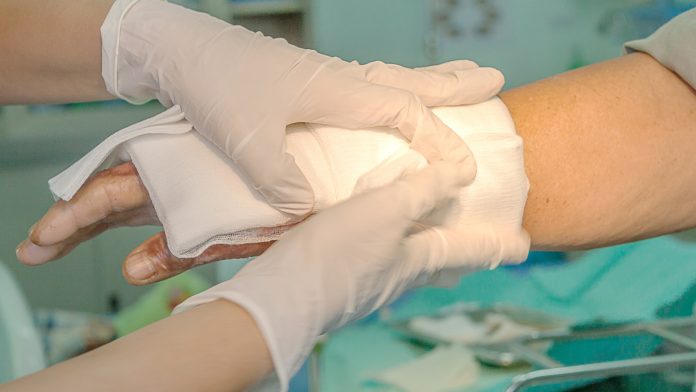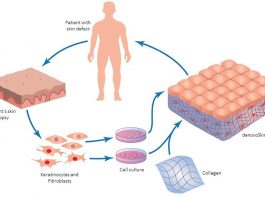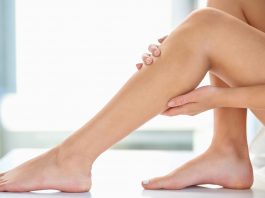CUTISS’ CEO Dr Daniela Marino explains the current challenges and opportunities in regenerative therapy for burn victims and patients with skin defects.
Skin is the largest organ in the human body, composed mainly by an outer epidermis and an inner dermis. It is our interface to the outer world and its total loss is incompatible with life. In contrast to small skin lesions, if large proportions of epidermis and dermis are lost, the resulting full-thickness defects (FTSD) represent a significant, and sometimes unsolvable, problem for surgeons.
Typical conditions that often lead to extended full thickness skin loss are burns, avulsion injuries, septic skin necroses, and iatrogenic skin defects.1 Today, FTSD are treated by means of skin autografting – a split-thickness skin graft (STSG) is harvested from a healthy donor site of the patient’s body and is then transplanted on to the full-thickness wound. STSG, being composed of epidermis and remnants of dermis, are thinner than the wounds. Therefore, after transplantation, scar tissue is deposited to fill up ‘the gap’ and contraction is promoted to try and reduce the wound volume.
During the acute phase, the donor site shortage represents an unmet need that can potentially be lethal. In mid-long term, scarring becomes the major issue. Scars are not just disfiguring but also debilitating, highly discomforting, and can impair mobility, growth and require corrective surgeries, intense homecare and psychosocial rehabilitation.1
The solution
denovoSkin™ is a personalised bio-engineering dermo-epidermal skin grafts that offers a solution to the lack of permanent skin coverage. The Advanced Therapy Medicinal Product (ATMP) developed at CUTISS, is made of cells isolated from a stamp-sized patient’s split-thickness biopsy and it comprises both an epidermal and a dermal component. Therefore, there is no rejection issue after transplantation and the product is safe. denovoSkin is currently manufactured with a classical manual procedure where cells are isolated, amplified in 2D and then combined into a skin-like graft using a collagen hydrogel scaffold in 3D. The hydrogel is plastically compressed to ensure mechanical stability and user friendliness (surgeons are used to apply skin on wounds by means of sutures, staples, glues etc.).
However, CUTISS’ Research and Development team is working full speed on the scale-up and automation of the manufacturing process supported by an EU H2020 SME Instrument grant, EU H2020 SME Innovation Associate grant and a Swiss Innosuisse Grant. Two major Swiss engineering companies are also involved (Zühlke engineering and CSEM). The ultimate goal is to position denovoSkin as the first-in-class automated-produced tissue therapy that can treat both children and adults in a safe, effective and accessible way.
The automation program is focusing on three main automated modules:
- Cell isolation;
- Cell expansion; and
- Tissue formation.
Each module will replace the corresponded manual process. In a second step, the three modules will then be integrated to create an automate production line. The production of skin tissue in the automate has several advantages (e.g. robustness, consistency, reproducibility, safety, shorter production time and smaller costs). The standard of care today follows no specific guidelines when large, deep wounds are to be permanently treated. The healthy skin remaining on the patient body is the only means of real coverage and therefore, it is harvested thin (split thickness skin graft, STSG), and meshed repeatedly. This means that the donor site is also wounded and very often patient suffer sever donor site morbidity. Unfortunately, donor site shortage is a clear unmet clinical need for large and deep skin defects. A few options are available to the surgeons e.g. reCell®, Keratinocyte Sheets and dermal templates, however all those are applied on meshed STSG.
denovoSkin, with its permanent, dermo-epidermal structure has the potential to bring in new standards in skin grafting. With the use of denovoSkin, surgeons could avoid the re-harvesting and meshing of STSG. The healthy donor site could be optimally used, aesthetic outcome would be superior and functionality as well. Importantly, after the burn acute phase, denovoSkin could then be very beneficial to burn survivors that need/want to correct their scars. Other kinds of elective/reconstructive indications (tumour resections, plastic surgery, etc.) may also benefit from our technology.
Phase I safety trial completed
To determine whether this skin substitute could safely provide permanent defect coverage, a phase I clinical trial was performed at the University Children’s Hospital Zurich. 10 paediatric patients with acute or elective deep partial- or full-thickness skin defects were included. Skin grafts of 49cm2 were bioengineered using autologous keratinocytes and fibroblasts isolated from a patient’s small skin biopsy specimen (4cm2), incorporated in a collagen hydrogel.
Results
Graft take, epithelialisation, infection, adverse events, skin quality, and histology were analysed. Median graft taken at 21 days postoperatively was 78% (range, 0-100%). Healed skin substitutes were stable and skin quality was nearly normal. There were four cases of hematoma leading to partial graft loss. Histology at three months revealed a well-stratified epidermis and a dermal compartment comparable to native skin. Mean follow-up duration was 15 months.
Conclusion
In the first clinical application of this novel skin substitute, safe coverage of skin defects was achieved.2
Phase IIb efficacy trials recruiting
denovoSkin has received Orphan Drug Designation for the treatment of Burns by Swissmedic, EMA and, FDA. It is now in Phase II efficacy trials in Europe (NCT03227146, NCT03229564, NCT03394612). denovoSkin is a safe product and now the success of the efficacy trials is directly dependent on the patient willingness to participate to the study. We are actively recruiting at University Children’s Hospital in Switzerland, University Hospital in Zurich, VUmc Center in Amsterdam, and the Dutch Burn Centre in Beverwijk.).
We can recruit pediatric and adult patients with acute burns, but also with a need for elective skin grafting (e.g. scar reconstruction, tumours, nevi, and plastic surgery,). Importantly, burn compassionate patients admitted at European or Swiss hospitals may also be grafted with denovoSkin.
Financial history and future plans
Incorporated in March 2017, CUTISS is a spin-off of the University of Zurich (UZH). After completion of the Safety Phase I trials funded by the FP7 EU program, in October 2016, the startup incubator ‘Wyss Zurich’ decided to financially support the Phase II trials for denovoSkin. In July 2017, soon after incorporation, the newly funded UZH Life Science Fund, a joint venture of UZH Foundation and Novartis Venture Fund, injected a seed round of 1m CHF (~€786,000) to launch the automation of production of denovoSkin.
In May 2018, CUTISS Ltd, with a team of six people, closed a Serie A with 7.26mCHF (lead investor, Giammaria Giuliani, from Giuliani Pharma) and received grants for €4m. As of Today, CUTISS’ team is composed of 19 people involved in R&D, automation, production, and clinical trials – a very strong, experienced team that works in close relation with clinical, regulatory and engineering partners. CUTISS has its own R&D labs and is building its own GMP facility to scale up manufacturing, at the Bio-Technopark in Zurich-Schlieren. Series B is now open to raise 30m CHF. to support all the activities up to 2023.
Challenges and opportunities: a thin line in between
CUTISS is an emerging company with a very visionary mission. We want to provide best of the art regenerative therapy to help millions of patients in need for new skin. We want to achieve this in the shortest time possible, with the best results possible for our patients. Therefore we are approaching our vision in a challenging fashion, running a rather dense operational plan. Clinical trials, scale up of manufacturing, a new facility being built, a technology transfer, automation on the run, company building, and a community building. All those in a rather new, evolving medical field.
We believe that we possess the right expertise, knowledge, motivation and support needed to succeed. The clinical work we are performing will provide us with important information about wound healing and management, and the scale up of manufacturing will give us the unique chance to prove that personalised tissue therapy can be a reality for many. Also, building a new facility will teach us how to best deliver at a global level, and the automation will reveal pioneering aspects of tissue engineering that have never been revealed before.
Building CUTISS will be a journey started as many others in academia, a journey that is all but smooth sailing and clearly demonstrates that hard work, commitment, courage and dedication can re-write the rules and build a community that serves the needs of society.
References
1 Marino, D., Reichmann E,., and Meuli,M. 2014. Skingineering. Eur J Pediatr Surg. 2014 Jun;24(3):205-13. doi: 10.1055/s-0034-1376315
2 Meuli, M. et al. 2019. A Cultured Autologous Dermo-Epidermal Skin Substitute for Full Thickness Skin Defects: A Phase I, Open, Prospective Clinical Trial in Children. Plastic and Reconstructive Surgery, Printing in process. Published in June 2019. DOI: 10.1097/PRS.0000000000005746
Dr Daniela Marino
CEO
CUTISS AG
+41 76 230 8046
daniela.marino@cutiss.swiss
www.cutiss.swiss
Please note, this article will also appear in the first edition of our new quarterly publication. Subscribe to our updates for free here.










